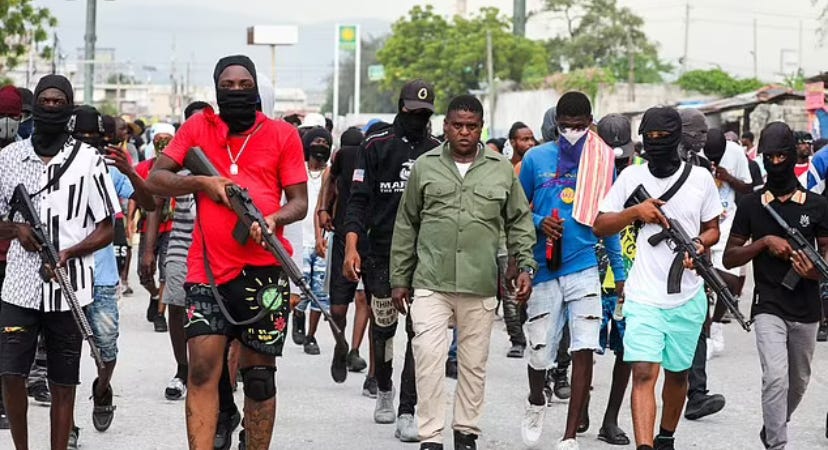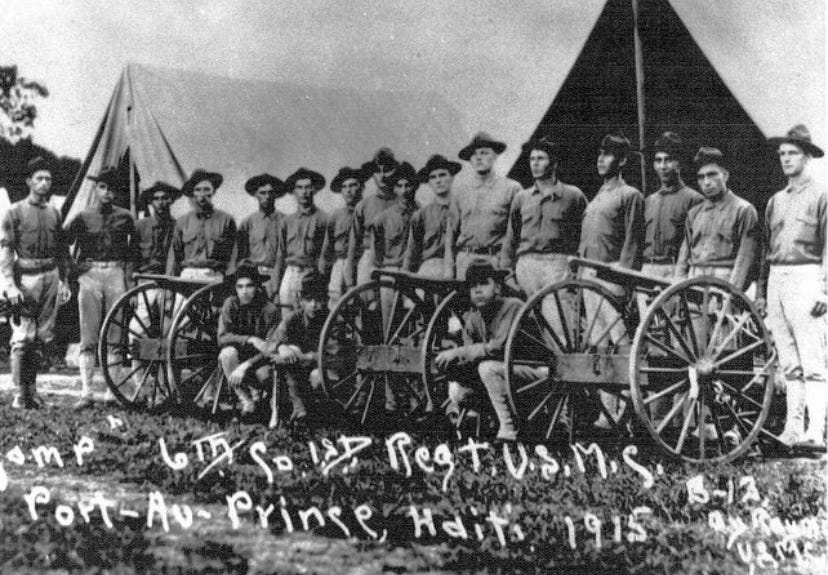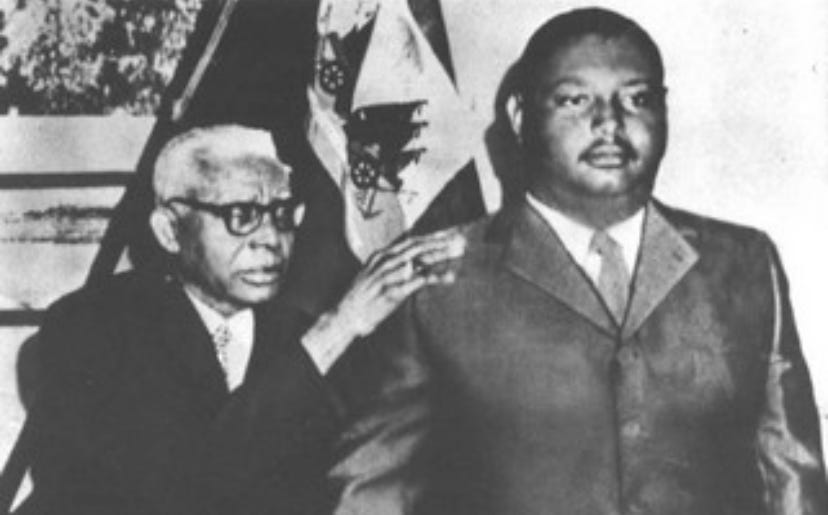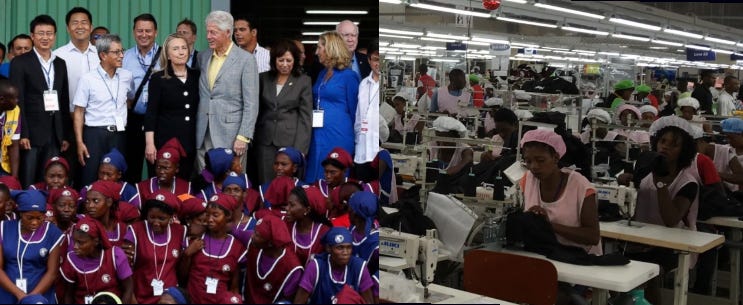K.D.Lewis Jimmy “Barbecue” Chezizier and the G9
Jimmy “Barbecue” Chezizier and the G9
The Revolutionary Mischaracterized as a Butcher
The current state-sponsored news coverage regarding the island of Haiti, describes its current state as one infested with gang violence including heinous acts ranging from trafficking to rape to cannibalism with one of its ring leaders being Ex-Police Officer, Jimmy Chezizier, nicknamed “Barbecue”. It is such accused violence that serves as an incurious justification for financially sanctioning the leader of Haiti’s largest anti-crime militia as well as supporting a U.S. backed intervention utilizing Kenyan and other ECOWAS militaries to seize the nation.
The propaganda surrounding Chezizier’s resistance group’s (known as the G-9) actions against the local perpetrators of violence has provided cover for the imperialist aspirations of the United States’ military industrial complex. Dan Cohen’s 3-part documentary Another Vision: Inside Haiti’s Uprising would display Chezizier in the light of a community leader of the impoverished town of Delmas whose entrance into revolutionary resistance began with his desire to protect his home of Delmas 6 from gang violence and his disillusionment from the effectiveness of Haiti’s judicial and law enforcement system. He noticed the bourgeois class colluded with police and government leaders to avoid accountability from the country’s criminal justice system.
Though formed in 2020 following Chezizier departure from Haiti’s UDMO police force, the G9, accused of being an international criminal organization, would see greater expansion after a police sponsored attack against various areas of Delmas, using gangs from Ruelle Maillart to burn down homes and bulldoze schools. These opposition gangs to the G9 are reportedly sponsored by Haiti’s wealthy class and the Organization of American States (OAS). No human rights organizations reported on such a massacre as well, including the United States backed Haitian human rights group, the RNDDH.
The response from Chezizier to these acts included providing shelter and food within undamaged sectors of Delmas as well as an avocation and plea for unity among the poor armed gangs and militias to resist what he describes as the top 5% families that own and control 85% of Haiti’s wealth. Despite antagonism from various parties including the U.S. sympathetic leadership in Haiti, the violent bourgeois-backed gangs, the Western media, and a U.S. government prepared for intervention, Jimmy Chezizier holds to his vision of a unified proletariat revolution against the corrupted bourgeois system while also opposing foreign intervention from Western powers, specifically the United States.
What is happening in Haiti is not new. In fact, since its inception, the western half of the island known as Hispaniola has suffered decades upon decades of internal and external strife. However, the solution to this strife must come from Haitian masses not the Haitian elite and especially not a Western super power. In this article, we will explore Haiti’s long history dealing with European and American interventions and occupations that have actively hindered the economic and societal progression of the state, for understanding this imperialist history in relation to Haiti’s state of turmoil is vital in ensuring the protection of the country’s autonomy through a unified call against another foreign occupation and unified support for a proletariat-centered resistance movement akin to the Chezizier vision.
Haiti’s Postpartum Depression caused by Western Theft
On January 1, 1804, the world’s first black independent nation following centuries of European settler colonialism was established. Formerly known as San Domingue, Haiti successfully defeated and ousted its colonial oppressors after a 13 year revolt turned revolution. As monumental of a victory this newly acquired independence was, the immediate response from Western imperialism has contributed greatly to the nation’s perpetual state of misery.
Just two decades following their independence, Haiti was forced to pay their former enslavers for their independence at gun-point. Receiving their final payment from the Haitian government in 1922, France successfully stole $560 million (value in 2022) from Haiti. This stolen money was used to not only construct marvels such as the Eiffel Tower, but also build France’s banking system, benefitting the Credit Industriel et Commercial (C.I.C) the most. The New York Time’s “The Ransom” explains how this vindictive looting of Haiti has resulted in the loss of upwards of $21 Billion had the money remained with Haiti. This singular action by a colonial power had a grand negative impact on Haiti’s development as a nation, and it was only the first.
Happening almost simultaneously with this heist, the United States set its sights on the resource rich yet economically destitute nation of Haiti, starting with President Andrew Johnson’s aspirations to annex the entire island of Hispaniola in 1868. His successor, Ulysses S. Grant would support a commission tasked with generating positive PR for the possible annexation of Santo Domingo, utilizing Frederick Douglass as the face of black support for this imperialist action. Though a vote for the annexation would fail in the U.S. Senate, the United States would continue to include itself in the nation’s affairs, later invading and occupying Haiti in 1915.
 United States Marine Corp stationed in Port-Au-Prince. 1915
United States Marine Corp stationed in Port-Au-Prince. 1915
This occupation lasted for 19 years. During that time, the United States stole upwards of $500,000 from Haiti’s National Bank and transferred that money into various banks on Wall Street, Citigroup being one of those banks. This act essentially gave the U.S. unilateral control over Haiti’s largest financial institution.
Corporate Exploitation and Dictators
After the Good Neighbor Policy of 1934 led to the complete removal of American troops from the island, World War II offered yet another opportunity for the West to exploit Haiti’s resources. In 1941, the Haitian Government with the United States established the Société Haitiane-Américaine de Développement Agricole (SHADA).
This entity was an agricultural corporation financed and controlled by the Export-Import Bank of the United States (EXIM). Its board consisted of 3 Haitian and 3 American representatives, and key leaders in the corporation were American as well. This initiative was designed to expand Haiti’s agricultural-based economy and focus on rubber production during the war. The end result of SHADA left the Haitian government $4,000,000.00 in debt to EXIM, the United States and Canada replacing Europe (France specifically) as the largest importers of Haitian goods, and the loss of farmland for Haiti’s “peasant class” to the SHADA corporation.
From this point to the late 1980s, Haiti suffered under dictatorial rule of faux-populist Francois Duvalier and later his son, Jean-Claude Duvalier.
 Francios “Papa Doc” and Jean-Claude “Baby Doc” Duvelier
Francios “Papa Doc” and Jean-Claude “Baby Doc” Duvelier
The Duvalier reign began in 1957 as a response to violence from the mulatto population mainly stemming from the Dominican Republic. Francois “Papa Doc” Duvalier expressed a vision of dominant political and economic power held by the black masses early into his administration. His actions, on the other hand, were that of a demagogue who ended up establishing his own corrupt paramilitary dubbed “The Bogeymen ” that terrorized the local population. Later in 1964, he declared himself “Ruler for Life ”.
Under his leadership, Haiti suffered from a lack of tourism, an increase in tensions with the D.R., and extreme repression from his regime. His 19 year old son, nicknamed “Baby Doc” would replace him in 1971. Though Jean-Claude Duvalier’s approach to rule focused more on establishing an image of international respectability, the remnants of his father’s leadership would lead to a mass uprising ousting the dictatorial dynasty in 1987.
A Sanguine Transition Thwarted by Traitors
In the later winter of 1991, social and economic reformist Jean-Betrand Aristride, overwhelmingly supported by the Haitian masses, would hold the mantle of Haiti’s first democratically elected president. This victory was short-lived.
Some of Aristride’s ambitious reforms included extending more civilian control over the army, the “encouraged” retirement for military leaders of the last long-standing regime, and abolishing the corrupted system of rural chiefs, who stole land from poor peasants. It was these perceived attacks on the wealthy and former military authorities that sparked a coup d’etat against Aristride only seven months after his election. The coup was led by Lieutenant General Raoul Cedras, who later received amnesty and thousands of dollars in payments per month to reside in a secluded area in Haiti, both received from the U.S. government.
What followed this coup were acts of extreme violence from the military junta against various worker, farmer, and student resistance groups and supporters of Aristride. These actions included armed attacks against independent Haitian radio stations and the mass arrest of 150 students associated with the Federation of Haitian Students (FENEH).
The response from the United States intelligence agencies under George H.W. Bush presidency was a mix of facilitating negotiations between Cedras’ faction and Aristride and a series of character-assassination against Aristride, blaming the accused human rights violations from his supporters toward the Duvalier-sympathetic opposition to Aristride for the 1991 coup d’etat.
Contrastly, in the following Clinton Administration, the harsh tone toward Aristride would subside, in fact, this administration would spearhead a military intervention to remove the repressive Cedras regime in Operation Uphold Democracy. This benevolent action, however, is contradicted by the C.I.A. ‘s involvement in backing the very regime that helped Cedras overthrow Aristride and operated as an active organization against his reinstallment as president, the Front for the Advancement and Progress of Haiti (FRAPH).
 LEFT: FRAPH Militia. RIGHT: CIA asset and leader of FRAPH, Emmanual Constant
LEFT: FRAPH Militia. RIGHT: CIA asset and leader of FRAPH, Emmanual Constant
FRAPH was implicated as active participants in the Haitian Armed Forces (under Cedras) acts of violence, terror, and repression per the Center for Justice & Accountability. Its leader, Emmanuel “Toto” Constant, was exposed for being an asset for the C.I.A. in 1993, likely since the initial ousting of Aristride in 1991. Nonetheless, the 1994 occupation of Haiti by the United States (again) would “successfully ” remove Cedras and his faction from power, paving a way for Aristride’s return.
A Second Chance Destroyed by Greed and Colonial Instinct
The return of Aristride was not an action of goodwill by the U.S. as imperialists may believe, however a transactional act with the conditions that Aristride would develop economic policies that meet the approval of Western power, one condition being the complete privatization of Haiti’s state-owned enterprises. A condition Aristride didn’t follow, presumably due to the nature of the condition opening a huge window for American economic control in the sovereign nation of Haiti.
This refusal to submit to Western-will coupled with the overwhelming support Aristride and the Lavashe party (the “progressive” party associated with Aristride) received from the proletariat made the democratically elected president a threat and a target.
After winning his second election, Aristride would face opposition from leftover remains of the U.S. backed FRAPH and West-friendly Haitian elite. A notable opposition leader was Andre Apaid, a factory-owner with a U.S. passport who led a gang called “the Group of 184”, believed to be conjured for the purposes of painting Aristride and his regime as authoritarian. Alongside them, the aforementioned violent and oppressive FRAPH, which continued its practice of terrorizing, maiming, and abusing Aristride supporters.
The United States saw the inevitable bloodshed caused by the past actions of its meddling in Haitian affairs and used it as leverage to force Aristride into exile in 2004. Afterwards, the United States military would again enter Haiti and quickly dispose of the violent opposition to Aristride. With the help of France and sanctions supported by the United Nations, Haiti’s first elected president was replaced by Chief Justice of the Supreme Court, Boniface Alexandre, acting as the face of a puppet regime to the UN. This regime change included replacing the Lavashe majority in leadership with a cabinet full of former Duvelier-ists.
The Exploitation of a Natural Disaster
Many still haven’t forgotten the devastation of the 7.0 Earthquake that struck Haiti just a few weeks into 2010, but many may not be aware of the devastation caused by the U.S. failure of a response to this natural catastrophe. Under the supervision of then Secretary of State, Hillary Clinton, the U.S.-led humanitarian response consisted of haphazard management and faulty oversight of the nongovernment organizations (NGOs), most notable example being the Red Cross unaccounted half a billion dollars in donations.
There was also very little care for the autonomy of the local population, pointed out by Clinton’s own daughter. She would also find issue with the lack of security offered by U.S. military presence. The more sinister acts of the Clintons was the pimping of the “charitable” Clinton Foundation and Clinton-Bush Haiti Fund, which received donation pledges totaling $10 Billion.
 Establishment of Caracol Industrial Park, Employees reported to earn $5 a day
Establishment of Caracol Industrial Park, Employees reported to earn $5 a day
After raising this money, Bill Clinton would be appointed as co-chairman of the Interim Haiti Recovery Commission. This essentially granted him direct control over the money received through both foundations, leaving nothing much to show other than nickeled-and-dimed assistance and a failed $300 million garment industrial park established by the Clintons and a fashion executive in 2012.
Puppets and Patriots
This U.S. debacle successfully placed Haiti at the mercy of the U.S. The leaders during and following the failed attempt to save Haiti were Michael Martelly and Josavah Moise. Martelly, infamous for embezzling over $4 billion dollars of aid from Venezuela via the PetroCaribe agreement beginning under socialist Venezuelan president, Hugo Chavez in 2005. This stolen money is speculated to have been utilized to boost his successor, Moise, into power.
Under Moise, the living conditions in Haiti continued to deteriorate. The PetroCaribe agreement was effectively eliminated in 2017 due to the heavy sanctions placed on Venezuela by, who other than, the United States under the Trump administration. The end of the PetroCaribe would prove to be a bridge too far for the exploited masses, leading to mass civil disruption and the assassination of Moise in 2021.
His assassination left the prime minister, Ariel Henry as the current recognized head of state in Haiti. However, that view isn’t shared by the Haitian proletariat and its de facto leader, Jimmy Chezizier.
Jimmy Chezizier is a son of Haiti, with experience in fighting crime and the compassion grand enough to seek unity amongst all who suffer under the repression set upon them but their social and political elite as well as the Western foreign entity that insist on entangling itself with said Haitian elite, calling this new family “G9”. It is high time the first black independent nation be given the space and the courtesy of establishing their own path, especially that set forth by the poor masses in the nation.
Haiti’s history is riddled with the negative results of Western chauvinism. From paying its colonial oppressors in France millions in reparation to practically being the United States favorite toy, with its past three leaders being handpicked by the U.S. However, as there was Toussaint and as there was Aristride, there is a patriotic spirit in Chezizier and the G9 that deserves an opportunity to finally have a nation with true intentions to benefit the children of Haiti. We as the citizens of the imperial core must demand of our current and future leaders to keep their hands off of Haiti.
Haïti: The Barbecue Revolution – Civil War & Viv Ansanm’s Path to Power
Haiti: U.S. Imperialism, Get Out! and Take Your Presidential Council with You…